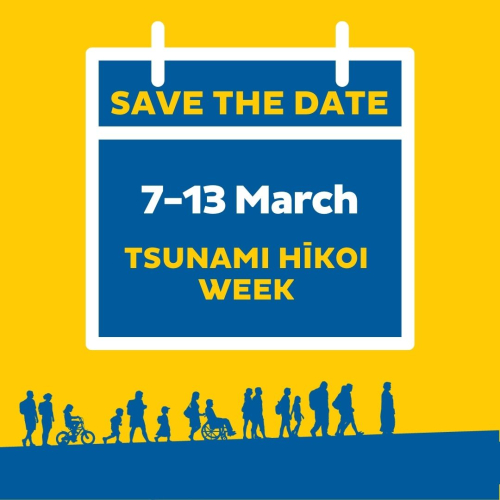

East Coast LAB and Hawke’s Bay Civil Defence Emergency Management Group (HBCDEM) are encouraging whānau, schools and businesses in the region to practise their tsunami evacuation routes as part of Tsunami Hīkoi week, which runs from 7 to 13 March.
Tsunami Hīkoi week is an annual initiative held by East Coast LAB, to mark the anniversary of the 2011 Japan earthquake and tsunami, which claimed the lives of 15,500 people in the Tōhoku region. The aim of Tsunami Hīkoi Week is to encourage people to learn and practice their tsunami evacuation route.
East Coast LAB project leader Georgia McCombe says it is important to know what to do if you feel a long or strong earthquake and whether you are in a tsunami evacuation zone.
“The East Coast of the North Island is especially at risk of tsunami, due to our proximity to Aotearoa’s largest and most active fault – the Hikurangi Subduction Zone. Because of this everyone who lives, works, or plays in a tsunami evacuation zone should know how to prepare for tsunami and know what to do to be safe,” Georgia McCombe said.
“Tsunami Hīkoi week is great chance for people to familiarise themselves with their evacuation route through a tsunami hīkoi. A tsunami hīkoi is a walk that takes you along your tsunami evacuation route either inland or towards high ground,” Georgia McCombe said.
“Walking the route you would take in an actual event is one of the best ways to prepare for a tsunami, as well as learning the natural warning signs of a tsunami: If an earthquake is long or strong, get gone,” Georgia McCombe said.
HBCDEM Group Manager Ian Macdonald says this year’s Tsunami Hīkoi week marks the 11th anniversary of the 2011 Japan earthquake and tsunami, with vital lessons learnt from that event.
“We know that practicing your tsunami hīkoi works because it helped save the lives of 95 per cent of people in Japan in 2011,” Ian Macdonald said.
“Practicing your evacuation walk will allow you to respond quicker when the real thing happens. It means that you, your workplace, household and whānau can all act immediately.
“Regularly practicing the walk, run or bike ride to your tsunami safe location is a great way to stay prepared and ensure you and your whānau will waste no time in reaching it,” Ian Macdonald said.
Ian Macdonald said that while all people around the country are managing a lot right now with COVID-19, it’s important not to lose sight of the other emergencies that can happen in Aotearoa.
“A local source tsunami could occur any time and could arrive in minutes, with no time for an official warning. So, it’s important to recognise the natural warning signs and act quickly. Remember, if you feel a long or strong earthquake, get gone. Self-evacuate immediately to high ground or inland,” Ian Macdonald said.
How to practise your tsunami hīkoi
Notes to editors
15 February 2023
Disclaimers and Copyright
While every endeavour has been taken by the Hawke's Bay Emergency Management to ensure that the information on this website is
accurate and up to date, Hawke's Bay Emergency Management shall not be liable for any loss suffered through the use, directly or indirectly, of information on this website. Information contained has been assembled in good faith.
Some of the information available in this site is from the New Zealand Public domain and supplied by relevant
government agencies. Hawke's Bay Emergency Management cannot accept any liability for its accuracy or content.
Portions of the information and material on this site, including data, pages, documents, online
graphics and images are protected by copyright, unless specifically notified to the contrary. Externally sourced
information or material is copyright to the respective provider.
© Hawke's Bay Emergency Management - hbemergency.govt.nz / / enquiries@hbemergency.govt.nz